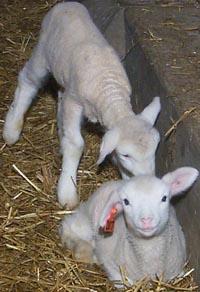Lambing School Welcomes 4-Hers
Lambing School Welcomes 4-Hers

For learning sheep management, nothing beats an up-close, hands-on experience. That’s what participants found out at the University of Kentucky College of Agriculture’s thirteenth annual winter lambing school at the Animal Research Center in Woodford county on February 6. Participants from Tennessee and Kentucky including several Greenup County 4-Hers, learned more about lambing, lactation, and basic management of a lamb’s first 72 hours of life.
 “We brought the kids here today to introduce them to the different parts of the lambing process and for educational purposes, so they know more about what they are raising,” said Cheryl Humphrey, Greenup county 4-H leader. “The kids who came with us today show lambs at the county fair.”
“We brought the kids here today to introduce them to the different parts of the lambing process and for educational purposes, so they know more about what they are raising,” said Cheryl Humphrey, Greenup county 4-H leader. “The kids who came with us today show lambs at the county fair.”
Monty Chappell, UK Extension sheep specialist, talked to 4-Hers about the basic management skills needed to raise lambs. He also discussed the treatment and control of internal parasites of sheep, creep feeding, different breeds of lambs, and management of all phases of a lamb’s life.
Winston Deweese, UK sheep center research specialist and shepherd, and Endre Fink, assistant shepherd, demonstrated several hands-on techniques in the barn. They showed participants how to deliver and weigh lambs, feed them with a stomach tube, dock tails, and castrate. They also discussed how to handle emergencies during the actual delivery.
 “I raise lambs every year and show them,” said Matthew Boggs, 13-year-old Greenup county 4-Her. “I want to learn more about lambs and what to expect when they are born and also, have a little fun. I know a few things already, like how the babies react to their mothers."
“I raise lambs every year and show them,” said Matthew Boggs, 13-year-old Greenup county 4-Her. “I want to learn more about lambs and what to expect when they are born and also, have a little fun. I know a few things already, like how the babies react to their mothers."
During the hands-on demonstration participants were able to watch several live births. Deweese and Fink supervised the lambing process. They said sometimes lambs need a helping hand to get their first breath.
“As long as they have a heartbeat, we never give up on them,” Deweese said.
The participants also had a chance to ask Monty Chappell questions about the basic management of lambs. One person asked about the best kind of bedding to use.
“Some really good straw would be economical, although if you are feeding complete diets, you are going to find that the lamb will eat the fresh straw,” Chappell replied. “If you don’t want to use straw, then use sawdust or something like that. I would recommend to spray the bedding down with some water to get it damp, so it will stay together better and it will have a crust on the top, so lambs are not likely to eat it.”
Chappell said that by the end of the lambing school, participants should be able to analyze breeding records, project lambing dates, understand the nutritional demands of the pregnant and lactating ewe and how to meet them, understand a comprehensive health program for the pregnant and lactating ewe and know many other management techniques.